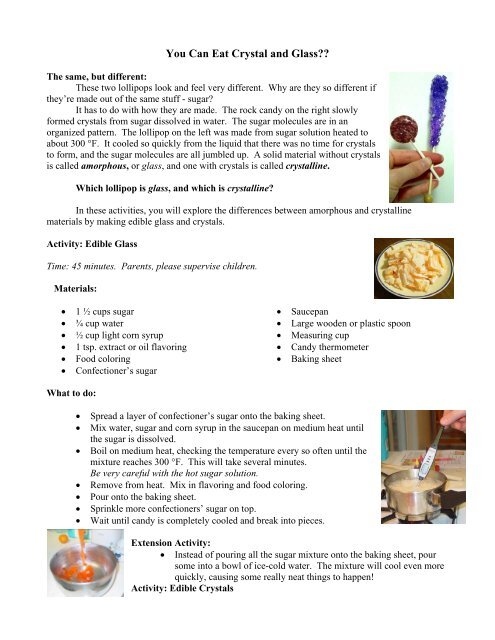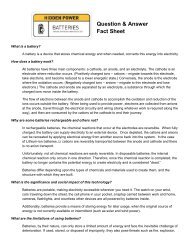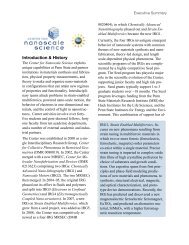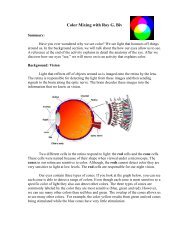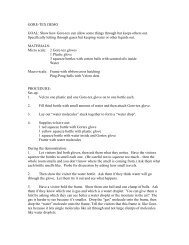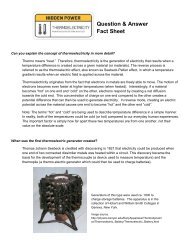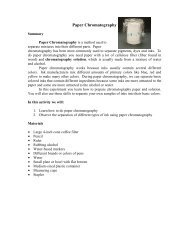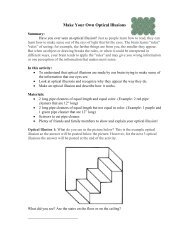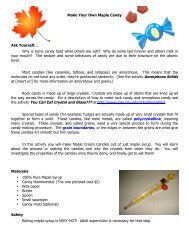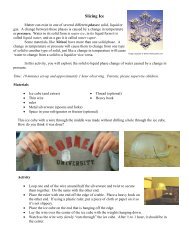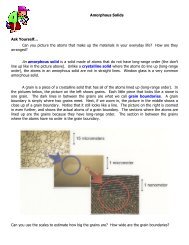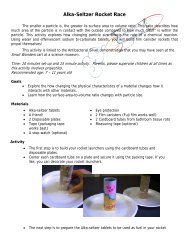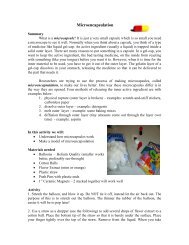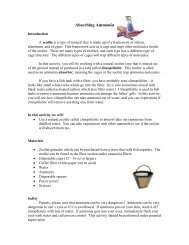You also want an ePaper? Increase the reach of your titles
YUMPU automatically turns print PDFs into web optimized ePapers that Google loves.
<strong>You</strong> <strong>Can</strong> <strong>Eat</strong> <strong>Crystal</strong> <strong>and</strong> <strong>Glass</strong>??<br />
The same, but different:<br />
These two lollipops look <strong>and</strong> feel very different. Why are they so different if<br />
they’re made out of the same stuff - sugar?<br />
It has to do with how they are made. The rock c<strong>and</strong>y on the right slowly<br />
formed crystals from sugar dissolved in water. The sugar molecules are in an<br />
organized pattern. The lollipop on the left was made from sugar solution heated to<br />
about 300 °F. It cooled so quickly from the liquid that there was no time for crystals<br />
to form, <strong>and</strong> the sugar molecules are all jumbled up. A solid material without crystals<br />
is called amorphous, or glass, <strong>and</strong> one with crystals is called crystalline.<br />
Which lollipop is glass, <strong>and</strong> which is crystalline?<br />
In these activities, you will explore the differences between amorphous <strong>and</strong> crystalline<br />
materials by making edible glass <strong>and</strong> crystals.<br />
Activity: Edible <strong>Glass</strong><br />
Time: 45 minutes. Parents, please supervise children.<br />
Materials:<br />
• 1 ½ cups sugar<br />
• ¾ cup water<br />
• ½ cup light corn syrup<br />
• 1 tsp. extract or oil flavoring<br />
• Food coloring<br />
• Confectioner’s sugar<br />
What to do:<br />
• Saucepan<br />
• Large wooden or plastic spoon<br />
• Measuring cup<br />
• <strong>Can</strong>dy thermometer<br />
• Baking sheet<br />
• Spread a layer of confectioner’s sugar onto the baking sheet.<br />
• Mix water, sugar <strong>and</strong> corn syrup in the saucepan on medium heat until<br />
the sugar is dissolved.<br />
• Boil on medium heat, checking the temperature every so often until the<br />
mixture reaches 300 °F. This will take several minutes.<br />
Be very careful with the hot sugar solution.<br />
• Remove from heat. Mix in flavoring <strong>and</strong> food coloring.<br />
• Pour onto the baking sheet.<br />
• Sprinkle more confectioners’ sugar on top.<br />
• Wait until c<strong>and</strong>y is completely cooled <strong>and</strong> break into pieces.<br />
Extension Activity:<br />
• Instead of pouring all the sugar mixture onto the baking sheet, pour<br />
some into a bowl of ice-cold water. The mixture will cool even more<br />
quickly, causing some really neat things to happen!<br />
Activity: Edible <strong>Crystal</strong>s
Time: 45 minutes <strong>and</strong> a few days wait time. Parents, please supervise children.<br />
Materials:<br />
• 2 ½ cups sugar<br />
• 1 cup water<br />
• Food coloring<br />
• Saucepan<br />
• Large wooden/plastic spoon<br />
• Measuring cup<br />
What to do:<br />
• Small glass jar<br />
• Piece of cotton string<br />
• Pencil<br />
• Plastic wrap<br />
• Clean washer or screw<br />
• Plate<br />
• Heat water in saucepan over medium to high heat until it boils.<br />
• Add sugar, <strong>and</strong> stir until liquid is clear <strong>and</strong> reaches a rolling boil.<br />
• Remove from heat. Add a few drops of food coloring.<br />
• Carefully pour sugar mixture into jar.<br />
• Tie washer or screw to one end of string, <strong>and</strong> tie the other end to the pencil.<br />
Dip string in sugar solution <strong>and</strong> take it out again. Lay string on plate. Leave<br />
out to dry overnight, then proceed to the next step.<br />
• Why am I letting the string dry?<br />
o Letting the string dry on the plate allows little sugar crystals to grow. It is on these<br />
little crystals that the big sugar crystals will grow.<br />
• Lower string into jar until pencil rests on top. Loosely cover the top with plastic wrap so dust<br />
stays out, but water can evaporate.<br />
• Leave someplace cool <strong>and</strong> out of the way. Don’t move it for several days.<br />
• When the crystals are big enough for your taste, eat the results!<br />
Question: Observe the c<strong>and</strong>y you have made, using your 5 senses. How are the properties of<br />
crystalline c<strong>and</strong>y <strong>and</strong> glass c<strong>and</strong>y the same? Different?<br />
Extension Activity:<br />
Make rock c<strong>and</strong>y with flavoring, or glass c<strong>and</strong>y without flavoring for a more direct<br />
comparison. Are flavoring <strong>and</strong> coloring incorporated differently into the two types of c<strong>and</strong>y?<br />
Connection to Nitinol:<br />
The organized structure of the atoms <strong>and</strong> molecules in a material give it its properties. Nitinol<br />
has two different organized crystal structures, or phases. When it is in one crystal structure, it is soft<br />
<strong>and</strong> bendable, <strong>and</strong> in another crystal structure, it is stiff <strong>and</strong> springy. Similarly, sugar c<strong>and</strong>y can have<br />
two different structures. The difference is that one type of c<strong>and</strong>y has an organized structure, <strong>and</strong> the<br />
other type of c<strong>and</strong>y is not organized at all.<br />
Did you know?
Nitinol isn’t the only material that has more than one crystal structure. Diamond <strong>and</strong> graphite<br />
(pencil lead) are two different phases of carbon. Steel <strong>and</strong> water ice both have many solid phases with<br />
different properties.<br />
For More Information<br />
• Lollipops.<br />
http://www.c<strong>and</strong>yusa.org/<strong>Can</strong>dy/lollipops.asp<br />
• Nitinol Information, from the Images SI, Inc. website:<br />
http://www.imagesco.com/articles/nitinol/01.html<br />
• What’s that Stuff? <strong>Glass</strong>. By Victoria Gilman.<br />
http://pubs.acs.org/cen/whatstuff/stuff/8147glass.html<br />
• Metal Makeover. By Peter Weiss.<br />
Science News. Nov. 6, 2004. Vol. 166 No. 19, pages 298-300.<br />
Vocabulary<br />
Amorphous: Having no organization or crystal form.<br />
<strong>Crystal</strong> Structure: The organized arrangement of the atoms within a material.<br />
<strong>Crystal</strong>line: Having an organized arrangement of atoms.<br />
<strong>Glass</strong>: Materials that become solid without forming an organized crystal structure.<br />
Phase: Any of the states in which matter can exist.<br />
Nitinol: An alloy of Nickel <strong>and</strong> Titanium that returns to its previous shape when you heat it.<br />
References:<br />
Science of Cooking: Rock <strong>Can</strong>dy http://www.exploratorium.edu/cooking/c<strong>and</strong>y/reciperockc<strong>and</strong>y.html<br />
Teaching General Chemistry: A Materials Science Companion. Arthur B. Ellis, Margret J.<br />
Gesselbracht, Brian J. Johnson, George C. Lisensky <strong>and</strong> William R. Robinson. Published by the<br />
American Chemical Society, 1993.


